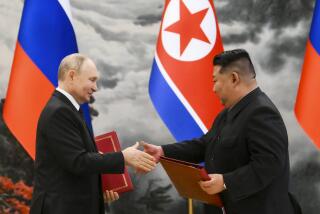Reselling Asians on U.S. Forces
- Share via
WASHINGTON — Historian John W. Dower, in his award-winning book about Japan at the end of World War II, “Embracing Defeat,” recalls the antipathy with which some Japanese viewed the arriving American occupation forces.
“Not you . . . not you. . . . It was not you we were waiting for,” wrote the Japanese intellectual Dazai Osamu, according to Dower’s account.
As President Clinton visits Okinawa this week, the huge strategic questions that underlie his trip are these: Will U.S. troops stay in East Asia as they have for more than a half-century?
Or is there a new dynamic underway that could lead, eventually, to a reduction in the American military presence?
At the moment, there are about 47,000 U.S. troops in Japan and 37,000 in South Korea. Two recent developments have renewed focus on these U.S. forces.
The first was the summit in Pyongyang between North Korean leader Kim Jong Il and South Korean President Kim Dae Jung. The second was the arrest of an American Marine on Okinawa for allegedly molesting a 14-year-old girl.
That arrest (and a subsequent hit-and-run accident involving an American staff sergeant) raises once again the touchy issue of why so many of the U.S. troops and bases in Japan are stuffed onto Okinawa. Clinton will try to defuse that problem with splashy events aimed at showing that the Americans seek “neighborly” ties with the people of Okinawa.
The impact of the Korean summit on the American presence is more subtle and more difficult for Clinton to address.
The prospect of a reconciliation between North and South Korea, or even Korean reunification, undercuts the long-standing rationale for the U.S. forces in South Korea. If the troops are not needed to defend South Korea against the North, why are they there?
Suppose the South Koreans decided there was no need for American troops anymore and asked them to leave. Then would Japan be willing to be the only country in East Asia with U.S. bases and troops, or would it too ask the Americans to depart?
That scenario represents a nightmare for the Pentagon. So, under the surface in Washington, there is considerable ferment over how to reconfigure or reduce the American military presence in Asia.
“The Army is quite upset about this subject,” observes Robert Ellsworth, a former U.S. ambassador to NATO. “They have studies going on among their retired guys and their active-duty people.” (Ellsworth notes that the Navy and Air Force feel more secure--because easing tensions on the Korean Peninsula would affect above all the need for ground troops to fight a land war in Asia.)
Even longtime champions of the American military presence in Asia acknowledge the need for a review.
“I think our basic structure in Asia is largely an outgrowth of World War II, the Korean War and the Vietnam War,” says James R. Lilley, former U.S. ambassador to South Korea and China. “It’s an outdated structure, dealing with a situation that has changed. There are threats, but they are taking different form.”
There’s an irony here. So far, the Republican foreign-policy establishment--traditionally hawkish and pro-defense--has been more willing to talk about the possibility of scaling back the U.S. troop deployments. Meanwhile, the Democrats, often less supportive of the U.S. military, have seemed more conservative on this.
In 1995, the Clinton administration established the so-called Nye initiative, in which the United States announced it would keep 100,000 American troops in East Asia for the foreseeable future. The administration is still wedded to this idea of preserving the status quo.
In response to the Korean summit, American officials also gradually are shifting the way they justify the U.S. troops and bases.
For years, the emphasis has been on the importance of defending against the threat of military attack. In the 1980s, the United States pointed to the Soviet threat; in the 1990s, there was said to be a continuing threat from North Korea.
U.S. officials don’t want to invoke now (at least not in public) a threat from China as a rationale for the American forces in Asia. And so, as the notion of a North Korean threat declines, American officials talk less about threats and more about the need for U.S. troops to preserve “stability” and the “balance of power” in Asia.
Lilley says Kim Dae Jung has accepted this idea and raised it in the recent summit. The South Korean president is said to have told Kim Jong Il that Koreans in both countries need the American troops to help protect them from their powerful neighbors Japan, Russia and China.
For America to sell this “balance of power” rationale in Asia, of course, requires some fancy footwork. It means persuading China that the American troops help prevent the rise of a militarized Japan, convincing Japan that the U.S. troops protect against a rising China and telling other Asians that the American forces protect them against both Japan and China.
At the moment, such arguments have enough plausibility to be accepted in Asia. Over the long run, they may prove a tough sell.
If China seems threatening, the American forces will no doubt be begged to stay. If not, Asia may eventually say to many of the U.S. troops, “Not you . . . not you,” and wish them farewell.
*
Jim Mann’s column appears in this space every Wednesday.
More to Read
Sign up for Essential California
The most important California stories and recommendations in your inbox every morning.
You may occasionally receive promotional content from the Los Angeles Times.













